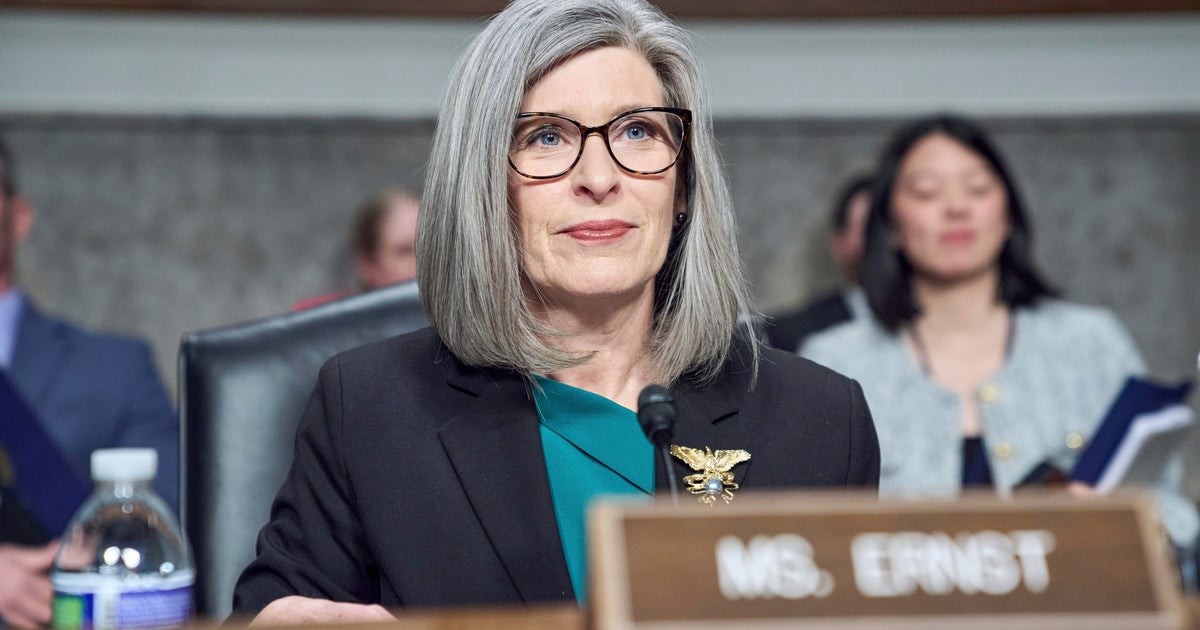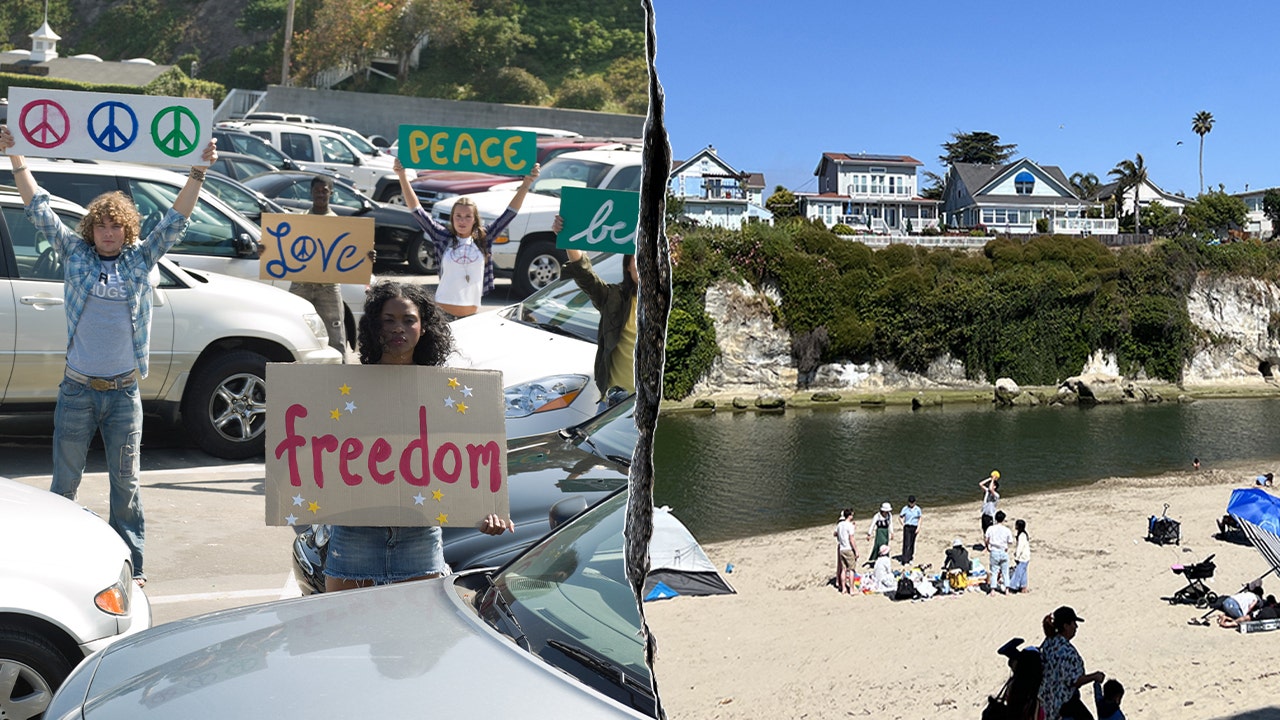Science
Outbreak of neurotoxin killing unprecedented number of sea lions along California coast
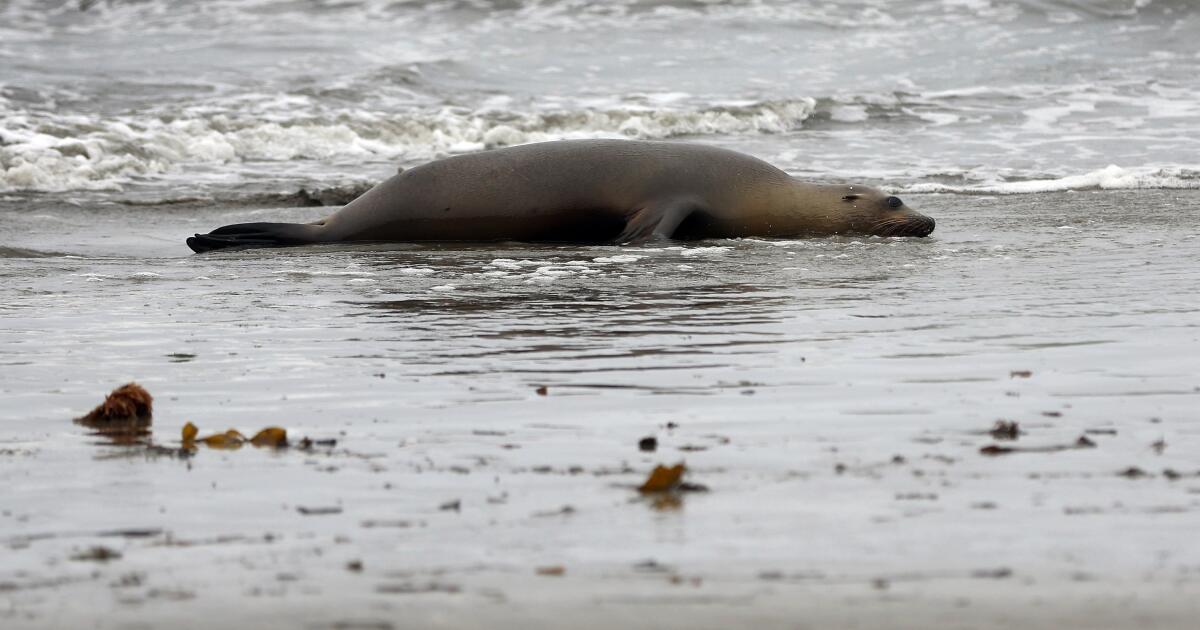
By the time the rescue squad got to her, a small crowd had formed around the agitated California sea lion. As the team crept toward her — carrying large wooden shields and a giant net — the animal’s head weaved, craned and rocked back and forth in frenzied rhythms.
Lucille — as she was later named by the Marine Mammal Center’s Morro Bay field office — had barely registered her captors’ approach as the team of five animal rescue volunteers pounced on her. A small struggle ensued as the creature’s body went rigid with seizures, but the team managed eventually to push her into an XXL portable dog crate.
“It’s really hard when they’re not acting like sea lions,” said Jake Roth, a 22-year-old volunteer who helped with the rescue.
It was the first of dozens of frantic rescue phone calls made by horrified beachgoers that day, as an acute domoic acid outbreak continued to wreak havoc along the San Luis Obispo and Santa Barbara coasts this summer.
“The levels we’re finding inside these animals is off the charts,” said Giancarlo Rulli, a spokesman for the Sausalito-based Marine Mammal Center. “It’s all hands on deck.”
Domoic acid is a neurotoxin released by Pseudo-nitzschia, a common phytoplankton species found in coastal waters. Sea lions — and other marine mammals — become poisoned when they eat large amounts of fish or invertebrates that have been chowing on the contaminated diatoms.
Symptoms include lethargy, vomiting, unusual behavior, seizures, loss of pregnancy and death.
Marine Mammal Center volunteer Cris Lewis guides a sick sea lion into a crate during a rescue at Cayucos State Beach.
(Justin Sullivan/Getty Images)
Domoic acid, which is an amino acid, is not always produced by the phytoplankton. It is only manufactured under certain conditions — ones which scientists are still trying to determine. But upwelling of seawater seems to be a common factor — and strong upwelling of cold, nutrient-rich water is currently hugging the Central California coastline.
The outbreak has been at crisis levels since late July.
“One of the things that has come out again and again in a lot of our studies… is that, yes, when you get upwelling — which is typified by colder water temperatures and lots of nutrients — you will stimulate a bloom of diatoms,” said Clarissa Anderson, director of Southern California Coastal Ocean Observing System and the Cooperative Institute for Marine, Earth, and Atmospheric Systems, which are operated out of UC San Diego’s Scripps Institution of Oceanography.
“But then the bigger question — the one we’ve not been able to totally wrap our heads around — is, when does it produce the toxin? What is the mixture of conditions that requires that? Because this organism is around all the time,” she said.
Domoic acid outbreaks are not new. They have been happening for decades, if not millennia. And although it wasn’t identified in California waters until 1991, it is believed to have been behind outbreaks before that — including the 1961 “invasion” of chaotic sea birds in Capitola that partly inspired Alfred Hitchcock’s 1963 film, “The Birds.”
What has changed, said Anderson, are the frequency, timing and location of the events.
“We know that upwelling season in California has always been a great time to expect a Pseudo-nitzschia bloom and potentially a domoic acid event, and that can start as early as March,” she said. As a result, scientists had associated springtime with domoic acid outbreaks.
“But now we’re starting to see something different: These past three summers there have been these intense, long, lasting blooms,” she said.
And while Monterey and Humboldt Bay had been considered the classical hot spots, it’s Southern California that has been clobbered since 2022.
She said climate change is likely playing a role in these changes — but not necessarily because of warm water temperatures.
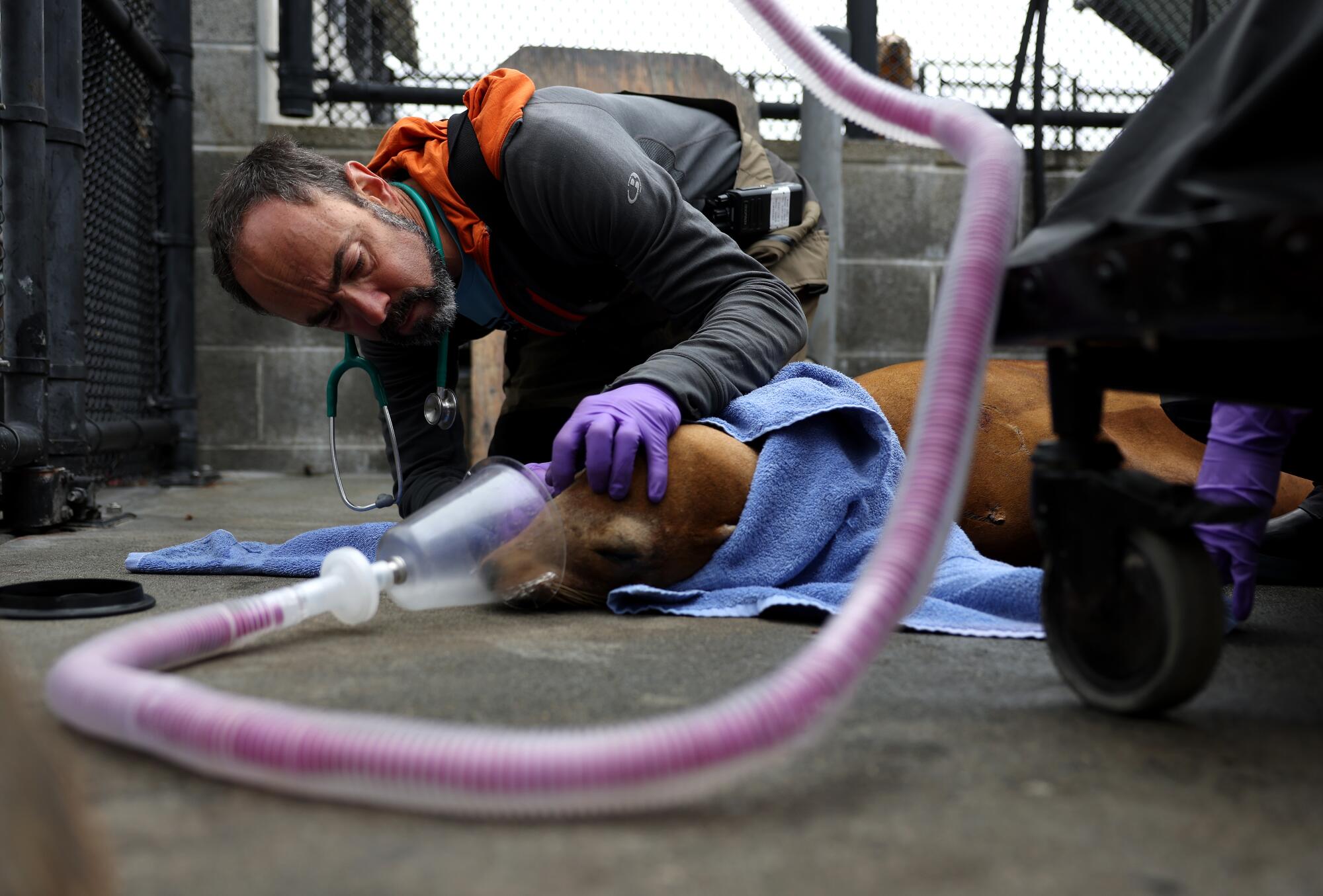
Marine Mammal Center veterinarian Greg Frankfurter inspects a newly admitted California sea lion that was rescued from a beach showing signs of domoic acid poisoning in Sausalito.
(Justin Sullivan/Getty Images)
“One of the things we have seen in our years and years and years of data is that it’s the mixture of nutrients that come with upwelling that is potentially responsible for turning the toxin on or off,” she said. “And that mixture of nutrients may be impacted by global climate change, because climate change is changing ocean circulation physics at the basin scale — like the Pacific Ocean scale — and that can have ramification on what kinds of water — the flavor of water — that is upwelling onto the coast in California.”
Raphe Kudela, a professor of ocean science at UC Santa Cruz, said there might also be a connection to heat and runoff from inland rivers.
He said in the last few years, really wet winters have contributed to an increase in river runoff — and a resulting dump of nutrients into California’s coastal waters.
“So you get a pulse of upwelling, which brought some cool water with even more nutrients to the surface, and then everything warmed up. That’s just absolutely perfect conditions for a bloom like this,” he said.
It’s also a perfect recipe for creatures like sardines and anchovies, who feast on the diatoms, algae and phytoplankton in these cool, nutrient-rich waters. And those fish bring in predators, such as sea lions, dolphins, fur seals, birds and other fish that then proceed to feast on these “toxic bullets.”
Anderson said people will occasionally ask her if they, too, could get sick from eating anchovies.
“I’m like, are you planning on eating as many anchovy as a sea lion?” she said, noting that sea lions eat roughly 5% to 8% of their body weight per day. For a 150-pound person, that would be 7.5 to 12 pounds of anchovy.
And that’s part of the tragedy of this latest outbreak.
Barbie Halaska, a necropsy specialist with the Marine Mammal Center, showed visitors the milk-rich tissue enveloping the single six-inch incisions she had made in the chests of six of the dead sea lions that had died at the Morro Bay center.
All six were adult, lactating females, she said, with thick layers of fat.
“You can see how big she is. She’s gorgeous,” said Halaska, pointing at the dead but otherwise healthy-looking animal. “They’ve got a great food supply. It just happens to be tainted. When they’re lactating, and they find a good food stock, they just go and go and go. Unfortunately, that means the neurotoxin just bioaccumulates.”
She said female sea lions tend to give birth around June 15 — “we call it sea lion birthday” — which means these females most likely had a young, dependent pup with them before they were stranded. Sea lion pups are dependent on their mothers until they are about 9 months old.
Research shows that pups growing inside contaminated pregnant females suffer brain damage. Milk from contaminated females also carries the toxin, suggesting it could be transmitted to pups.
By early afternoon, Lucille and three other sea lions were being treated for domoic acid poisoning.
Lucille was passed out, snoring on the cement floor of the pen. Soon after she arrived, a center staff member had delivered a shot full of phenobarbital and midazolam into her back haunch, to control the seizures. Staff then hooked her up to an IV bag of fluid to help flush the toxin out of her body.
But one of the three newer arrivals, a large, adult female named Yippee, arrived with a broken and dislocated jaw. Staff concluded she’d die if she was returned to the wild. They made the hard decision to medically euthanize her.
She struggled to flee from the small team that came in to deliver the shot, but was finally backed into a corner and succumbed. Her breathing slowed and within a few minutes, she was still.
Rulli said such episodes are always painful, and the center works hard to support staff who respond to these events. Repeated encounters with suffering animals can take a toll.
Roughly 30% of the animals that have come to the center in this latest outbreak — which began at the end of July — have died, said Aliah Meza, operation manager of the Morro Bay field office.
Farther south, where staff from the Channel Islands Marine Wildlife Institute are responding to animals along the Santa Barbara and Ventura coasts, the number exceeds 50%, said Sam Dover, founder and chief veterinarian of Channel Islands Marine and Wildlife Institute.
To keep these facilities running and these teams operating, both institutions rely on donations and some level of state and federal funding.
State funding was nearly pulled last year when the governor’s office struck $2 million in funding from the state budget. For smaller operations, such as Dover’s, that would have been a 50% hit on its operating budget. The groups were able to convince lawmakers to replace the funding.
“I don’t envy the sharpened pencil and eraser work that they were doing,” said Jeffrey Boehm, the marine center’s chief external relations officer, who said he and others went to Sacramento to make the case that their work is in the public interest. “Having an entity that is prepared, skilled and professional to respond to wildlife that might be having a seizure on a public beach, that’s in the public interest. As is the science we advance through doing this work… Because at the end of the day, it’s all just one system.”
Lucille, who recovered from her seizures, was transported to the center’s Sausalito hospital via air-conditioned truck the following day. She died in transport.
Veggie, another sea lion who was rescued the same day, did make it to Sausalito however. She is now undergoing a seven-day protocol at the hospital, where roughly 50 other sea lions are being treated.
Rulli said that two sea lions were recently released back into the wild at Point Reyes National Seashore, where there is no sign of an outbreak and where humpback whales are currently feeding — an indication that there’s plenty of food available.
“Let’s just hope they stay up here,” he said.

Science
Lawmakers ask Newsom and waste agency to follow the law on plastic legislation
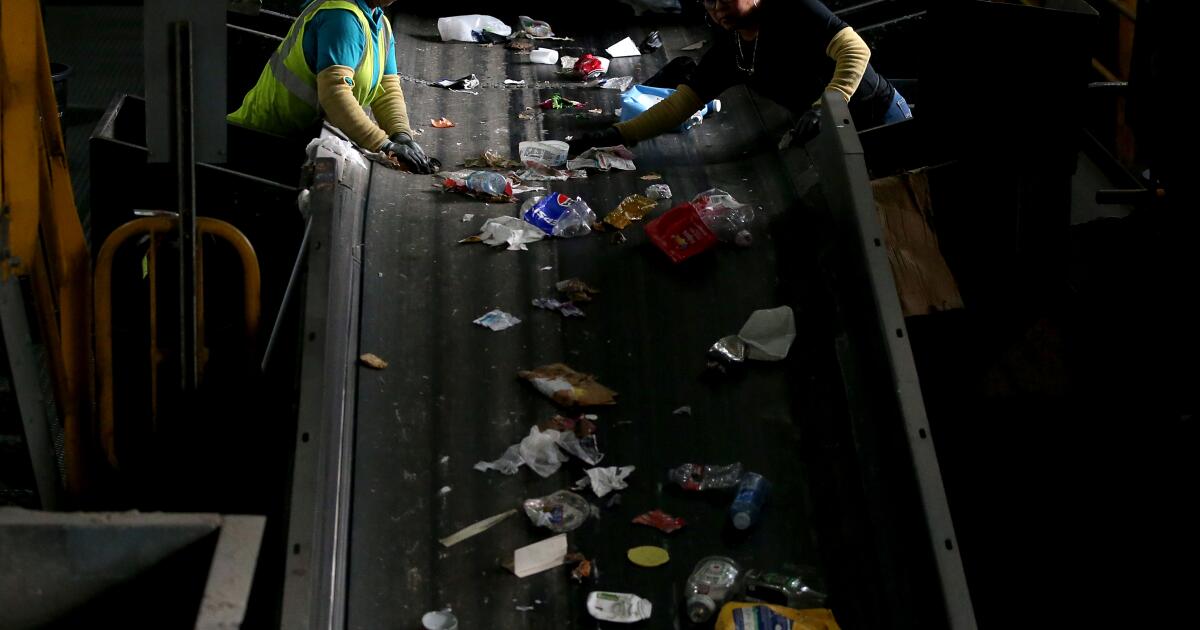
California lawmakers are taking aim at proposed rules to implement a state law aimed at curbing plastic waste, saying the draft regulations proposed by CalRecycle undermine the letter and intent of the legislation.
In a letter to Gov. Gavin Newsom and two of his top administrators, the lawmakers said CalRecycle exceeded its authority by drafting regulations that don’t abide by the terms set out by the law, Senate Bill 54.
“While we support many changes in the current draft regulations, we have identified several provisions that are inconsistent with the governing statute … and where CalRecycle has exceeded its authority under the law,” the lawmakers wrote in the letter to Newsom, California Environmental Protection agency chief Yana Garcia, and Zoe Heller, director of the state’s Department of Resources Recycling and Recovery, or CalRecycle.
The letter, which was written by Sen. Catherine Blakespear (D-Encinitas) and Sen. Benjamin Allen (D-Santa Monica), was signed by 21 other lawmakers, including Sen. John Laird (D-Santa Cruz) and Assemblymembers Al Muratsuchi (D-Rolling Hills Estates) and Monique Limón (D-Goleta).
CalRecycle submitted informal draft regulations two weeks ago that are designed to implement the law, which was authored by Allen, and signed into law by Newsom in 2022.
The lawmakers’ concerns are directed at the draft regulations’ potential approval of polluting recycling technologies — which the language of the law expressly prohibits — as well as the document’s expansive exemption for products and packaging that fall under the purview of the U.S. Department of Agriculture and the Food and Drug Administration.
The inclusion of such blanket exemptions is “not only contrary to the statute but also risks significantly increasing the program’s costs,” the lawmakers wrote. They said the new regulations allow “producers to unilaterally determine which products are subject to the law, without a requirement or process to back up such a claim.”
Daniel Villaseñor, a spokesman for the governor, said in an email that Newsom “was clear when he asked CalRecycle to restart these regulations that they should work to minimize costs for small businesses and families, and these rules are a step in the right direction …”
At a workshop held at the agency’s headquarters in Sacramento this week, CalRecycle staff responded to similar criticisms, and underscored that these are informal draft regulations, which means they can be changed.
“I know from comments we’ve already been receiving that some of the provisions, as we have written them … don’t quite come across in the way that we intended,” said Karen Kayfetz, chief of CalRecycle’s Product Stewardship branch, adding that she was hopeful “a robust conversation” could help highlight areas where interpretations of the regulations’ language differs from the agency’s intent.
“It was not our intent, of course, to ever go outside of the statute, and so to the extent that it may be interpreted in the language that we’ve provided, that there are provisions that extend beyond … it’s our wish to narrow that back down,” she said.
These new draft regulations are the expedited result of the agency’s attempt to satisfy Newsom’s concerns about the law, which he said could increase costs to California households if not properly implemented.
Newsom rejected the agency’s first attempt at drafting regulations — the result of nearly three years of negotiations by scores of stakeholders, including plastic producers, package developers, agricultural interests, environmental groups, municipalities, recycling companies and waste haulers — and ordered the waste agency to start the process over.
Critics say the new draft regulations cater to industry and could result in even higher costs to both California households, which have seen large increases in their residential waste hauling fees, as well as to the state’s various jurisdictions, which are taxed with cleaning up plastic waste and debris clogging the state’s rivers, highways, beaches and parks.
The law is molded on a series of legislative efforts described as Extended Producer Responsibility laws, which are designed to shift the cost of waste removal and disposal from the state’s jurisdictions and taxpayers to the industries that produce the waste — theoretically incentivizing a circular economy, in which product and packaging producers develop materials that can be reused, recycled or composted.
Science
U.S. just radically changed its COVID vaccine recommendations: How will it affect you?

As promised, federal health officials have dropped longstanding recommendations that healthy children and healthy pregnant women should get the COVID-19 vaccines.
“The COVID-19 vaccine schedule is very clear. The vaccine is not recommended for pregnant women. The vaccine is not recommended for healthy children,” the U.S. Department of Health and Human Services said in a post on X on Friday.
In formal documents, health officials offer “no guidance” on whether pregnant women should get the vaccine, and ask that parents talk with a healthcare provider before getting the vaccine for their children.
The decision was done in a way that is still expected to require insurers to pay for COVID-19 vaccines for children should their parents still want the shots for them.
The new vaccine guidelines were posted to the website of the U.S. Centers for Disease Control and Prevention late Thursday.
The insurance question
It wasn’t immediately clear whether insurers will still be required under federal law to pay for vaccinations for pregnant women.
The Trump administration’s decision came amid criticism from officials at the nation’s leading organizations for pediatricians and obstetricians. Some doctors said there is no new evidence to support removing the recommendation that healthy pregnant women and healthy children should get the COVID vaccine.
“This situation continues to make things unclear and creates confusion for patients, providers and payers,” the American College of Obstetricians and Gynecologists said in a statement Friday.
Earlier in the week, the group’s president, Dr. Steven Fleischman, said the science hasn’t changed, and that the COVID-19 vaccine is safe during pregnancy, and protects both the mom-to-be and their infants after birth.
“It is very clear that COVID-19 infection during pregnancy can be catastrophic,” Fleischman said in a statement.
Dr. Susan Kressly, president of the American Academy of Pediatrics, criticized the recommendation change as being rolled out in a “conflicting, confusing” manner, with “no explanation of the evidence used to reach their conclusions.”
“For many families, the COVID vaccine will remain an important way they protect their child and family from this disease and its complications, including long COVID,” Kressly said in a statement.
Some experts said the Trump administration should have waited to hear recommendations from a committee of doctors and scientists that typically advises the U.S. Centers for Disease Control and Prevention on immunization recommendations, which is set to meet in late June.
California’s view
The California Department of Public Health on Thursday said it supported the longstanding recommendation that “COVID-19 vaccines be available for all persons aged 6 months and older who wish to be vaccinated.”
The changes come as the CDC has faced an exodus of senior leaders and has lacked an acting director. Typically, as was the case during the first Trump administration and in the Biden administration, it is the CDC director who makes final decisions on vaccine recommendations. The CDC director has traditionally accepted the consensus viewpoint of the CDC’s panel of doctors and scientists serving on the Advisory Committee on Immunization Practices.
Even with the longstanding recommendations, vaccination rates were relatively low for children and pregnant women. As of late April, 13% of children, and 14.4% of pregnant women, had received the latest updated COVID-19 vaccine, according to the CDC. About 23% of adults overall received the updated vaccine, as did 27.8% of seniors age 65 and over.
The CDC estimates that since October, there have been 31,000 to 50,000 COVID deaths and between 270,000 and 430,000 COVID hospitalizations.
Here are some key points about the CDC’s decision:
New vaccination guidance for healthy children
Previously, the CDC’s guidance was simple: everyone ages 6 months and up should get an updated COVID vaccination. The most recent version was unveiled in September, and is officially known as the 2024-25 COVID-19 vaccine.
As of Thursday, the CDC, on its pediatric immunization schedule page, says that for healthy children — those age 6 months to 17 years — decisions about COVID vaccination should come from “shared clinical decision-making,” which is “informed by a decision process between the healthcare provider and the patient or parent/guardian.”
“Where the parent presents with a desire for their child to be vaccinated, children 6 months and older may receive COVID-19 vaccination, informed by the clinical judgment of a healthcare provider and personal preference and circumstances,” the CDC says.
The vaccine-skeptic secretary of Health and Human Services, Robert F. Kennedy Jr., contended in a video posted on Tuesday there was a “lack of any clinical data to support the repeat booster strategy in children.”
However, an earlier presentation by CDC staff said that, in general, getting an updated vaccine provides both children and adults additional protection from COVID-related emergency room and urgent care visits.
Dr. Peter Chin-Hong, a UC San Francisco infectious diseases expert, said he would have preferred the CDC retain its broader recommendation that everyone age 6 months and up get the updated vaccine.
“It’s simpler,” Chin-Hong said. He added there’s no new data out there that to him suggests children shouldn’t be getting the updated COVID vaccine.
A guideline that involves “shared decision-making,” Chin-Hong said, “is a very nebulous recommendation, and it doesn’t result in a lot of people getting vaccines.”
Kressly, of the American Academy of Pediatrics, said the shared clinical decision-making model is challenging to implement “because it lacks clear guidance for the conversations between a doctor and a family. Doctors and families need straightforward, evidence-based guidance, not vague, impractical frameworks.”
Some experts had been worried that the CDC would make a decision that would’ve ended the federal requirement that insurers cover the cost of COVID-19 vaccines for children. The out-of-pocket cost for a COVID-19 vaccine can reach around $200.
New vaccine guidance for pregnant women
In its adult immunization schedule for people who have medical conditions, the CDC now says it has “no guidance” on whether pregnant women should get the COVID-19 vaccine.
In his 58-second video on Tuesday, Kennedy did not explain why he thought pregnant women should not be recommended to get vaccinated against COVID-19.
Chin-Hong, of UCSF, called the decision to drop the vaccination recommendation for pregnant women “100%” wrong.
Pregnancy brings with it a relatively compromised immune system. Pregnant women have “a high chance of getting infections, and they get more serious disease — including COVID,” Chin-Hong said.
A pregnant woman getting vaccinated also protects the newborn. “You really need the antibodies in the pregnant person to go across the placenta to protect the newborn,” Chin-Hong said.
It’s especially important, Chin-Hong and others say, because infants under 6 months of age can’t be vaccinated against COVID-19, and they have as high a risk of severe complications as do seniors age 65 and over.
Not the worst-case scenario for vaccine proponents
Earlier in the week, some experts worried the new rules would allow insurers to stop covering the cost of the COVID vaccine for healthy children.
Their worries were sparked by the video message on Tuesday, in which Kennedy said that “the COVID vaccine for healthy children and healthy pregnant women has been removed from the CDC recommended immunization schedule.”
By late Thursday, the CDC came out with its formal decision — the agency dropped the recommendation for healthy children, but still left the shot on the pediatric immunization schedule.
Leaving the COVID-19 vaccine on the immunization schedule “means the vaccine will be covered by insurance” for healthy children, the American Academy of Pediatrics said in a statement.
How pharmacies and insurers are responding
There are some questions that don’t have immediate answers. Will some vaccine providers start requiring doctor’s notes in order for healthy children and healthy pregnant women to get vaccinated? Will it be harder for children and pregnant women to get vaccinated at a pharmacy?
In a statement, CVS Pharmacy said it “follows federal guidance and state law regarding vaccine administration and are monitoring any changes that the government may make regarding vaccine eligibility.” The insurer Aetna, which is owned by CVS, is also monitoring any changes federal officials make to COVID-19 vaccine eligibility “and will evaluate whether coverage adjustments are needed.”
Blue Shield of California said it will not change its practices on covering COVID-19 vaccines.
“Despite the recent federal policy change on COVID-19 vaccinations for healthy children and pregnant women, Blue Shield of California will continue to cover COVID-19 vaccines for all eligible members,” the insurer said in a statement. “The decision on whether to receive a COVID-19 vaccine is between our member and their provider. Blue Shield does not require prior authorization for COVID-19 vaccines.”
Under California law, health plans regulated by the state Department of Managed Health Care must cover COVID-19 vaccines without requiring prior authorization, the agency said Friday. “If consumers access these services from a provider in their health plan’s network, they will not need to pay anything for these services,” the statement said.
Science
Want to understand CalRecycle's chemical recycling rules? You'll need to pay

Sacramento — Want to know what constitutes an acceptable form of recycling in California under CalRecycle’s new draft guidelines for the state’s landmark plastic waste law?
It’ll cost you roughly $187, and even then you may not find your answer.
The issue arose this week when CalRecycle held a Sacramento workshop on its proposed regulations to implement Senate Bill 54, the 2022 law designed to reduce California’s single-use plastic waste.
In the regulations’ latest iteration, the agency declared that it will only consider recycling technologies that follow standards issued by the International Organization for Standardization, or ISO, the Geneva-based group that sets standards for a variety of industries, including healthcare and transportation.
According to the draft regulations: “A facility’s use of a technology that is not a mechanical recycling technology … shall not be considered recycling unless the facility operates in a manner consistent with ISO 59014:2024.”
To access ISO 59014:2024, one must purchase the report for about $187.
That’s not fair, said Nick Lapis, director of advocacy for Californians Against Waste. “Copies of those ISO standards should be publicly available,” he said.
Lapis and others also noted that the law, as written, expressly prohibits chemical and nonmechanical forms of recycling.
Officials at CalRecycle, also known as the California Department of Resources Recycling and Recovery, didn’t respond to the criticism or to questions from The Times.
ISO 59014:2024 turns out to be a 38-page report titled “Environmental management and circular economy — Sustainability and traceability of the recovery of secondary materials — Principles, requirements and guidance.”
A copy of the report reviewed by The Times offered no specifics on recycling technologies, or information about the operation of a recycling plant.
The word “recycling” is only used five times in the “Annex,” a 13-page supplementary section of the report. And there it is mentioned only in the context of establishing definitions or examples of “organizations engaged in the recovery of secondary materials” or “collection system types.”
For instance, “Commercial waste and recycling companies” are listed as examples of a type of organization that collects waste. Other waste collectors, according to the report, include municipalities, retailers and reuse organizations such as nonprofit reuse operators.
“The draft calls on aligning facilities with this ISO standard,” said Monica Wilson, senior director of global programs at the Global Alliance for Incinerator Alternatives. “That ISO standard is not about recycling. It’s not about chemical recycling, it’s just not an appropriate comparison for us to be referring to.”
Lapis also found the report hard to decipher.
“Maybe I should go back and look at it again, but it’d be helpful if you’re citing ISO standards … that you identify what parts” are being cited, he said.
Karen Kayfetz, chief of CalRecycle’s Product Stewardship branch, didn’t respond to questions or concerns about the inclusion of a report that is not freely available to the public to review.
During this week’s workshop, she said the agency’s use of the ISO standard “is not meant … to be a measure of whether you are recycling, but rather just one of multiple criteria that an entity needs to be measured against.”
She said the SB 54 statute requires that CalRecycle exclude recycling technologies that produce significant amounts of hazardous waste and tasks the agency with considering environmental and public health impacts of these technologies.
“The ISO standard for the operation of facilities does address some of the best practices that would help to ameliorate and measure those impacts. … It is meant to be one of multiple criteria that can be utilized as a measure and to help set a floor but not a ceiling,” she said.
Anna Ferrera, a spokeswoman for the Wine Institute, which represents more than 1,000 wineries and affiliates across the state, was among those with no complaints about the proposed new regulations.
“We believe it incorporates common-sense changes that would reduce costs and ensure that products are appropriately recycled,” Ferrera said.
Tina Andolina, the chief of staff for state Sen. Ben Allen (D-Santa Monica), SB 54’s author, said the inclusion of the report and other items in the draft regulations suggests that CalRecycle is considering how to manage these polluting technologies — instead of forbidding them, as the law requires.
“The regulations unlawfully shift the standard from the production of hazardous waste as required by the statute to its management,” she said, reading from a letter Allen had written to the staff.
Anja Brandon, director of plastic policy at the Ocean Conservancy, added that along with not being freely available, the ISO standard “does not satisfy SB 54’s requirements to exclude the most hazardous technologies and to minimize the generation of hazardous waste and environmental, environmental justice and public health impacts.”
SB 54, which was signed by Gov. Gavin Newsom in 2022, requires that by 2032, 100% of single-use packaging and plastic food ware produced or sold in the state must be recyclable or compostable, that 65% of it can be recycled, and that the total volume is reduced by 25%.
The law was written to address the mounting issue of plastic pollution in the environment and the growing number of studies showing the ubiquity of microplastic pollution in the human body — such as in the brain, blood, heart tissue, testicles, lungs and various other organs.
Last March, after nearly three years of negotiations among various corporate, environmental, waste, recycling and health stakeholders, CalRecycle drafted a set of finalized regulations designed to implement the single-use plastic producer responsibility program under SB 54.
But as the deadline for implementation approached, industries that would be affected by the regulations including plastic producers and packaging companies — represented by the California Chamber of Commerce and the Circular Action Alliance — began lobbying the governor, complaining that the regulations were poorly developed and might ultimately increase costs for California taxpayers.
Newsom allowed the regulations to expire and told CalRecycle that it needed to start the process over.
These new draft regulations are the agency’s latest attempt at issuing guidelines by which the law can be implemented.
-

 Business1 week ago
Business1 week agoPlastic Spoons, Umbrellas, Violins: A Guide to What Americans Buy From China
-

 Movie Reviews1 week ago
Movie Reviews1 week agoMOVIE REVIEW – Mission: Impossible 8 has Tom Cruise facing his final reckoning
-

 Movie Reviews1 week ago
Movie Reviews1 week ago‘Magellan’ Review: Gael Garcia Bernal Plays the Famous Explorer in Lav Diaz’s Exquisitely Shot Challenge of an Arthouse Epic
-

 Technology1 week ago
Technology1 week agoThe oldest Fire TV devices are losing Netflix support soon
-

 Maryland1 week ago
Maryland1 week agoMaryland, Cornell to face off in NCAA men’s lacrosse championship game
-
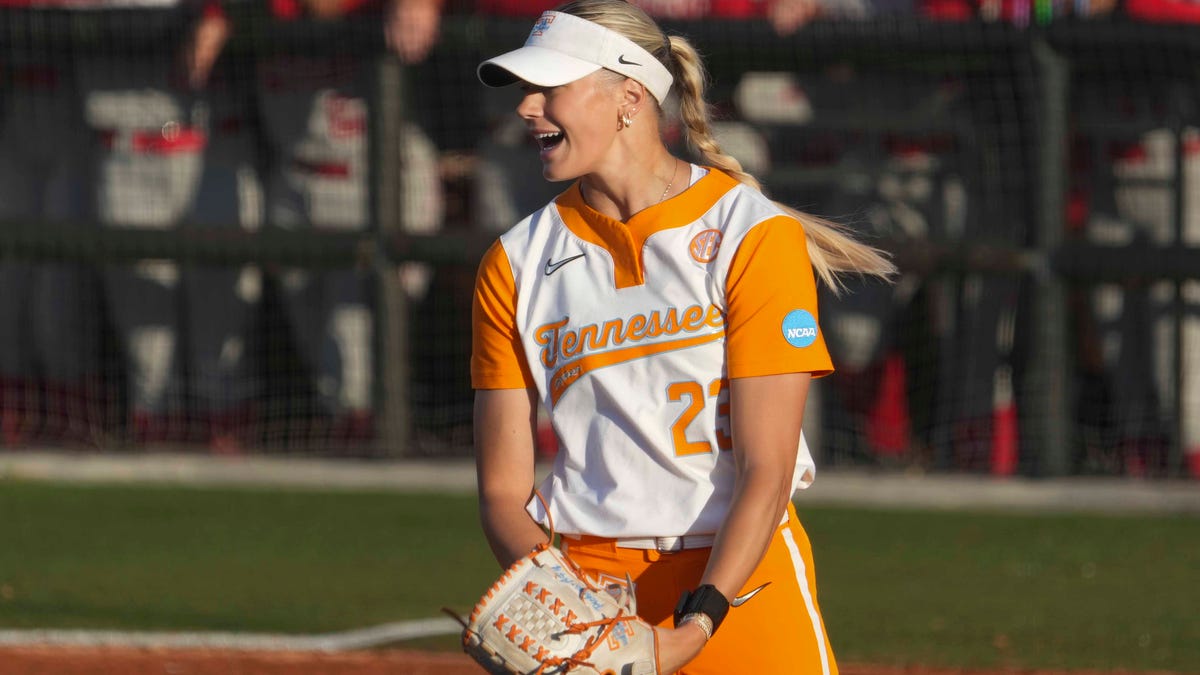
 Tennessee1 week ago
Tennessee1 week agoTennessee ace Karlyn Pickens breaks her own record for fastest softball pitch ever thrown
-

 World1 week ago
World1 week agoPower outage disrupts final day of Cannes Film Festival, police investigate possible arson
-

 Politics1 week ago
Politics1 week agoTrump talks with Putin, spars with South African leader, threatens EU tariff hike in 18th week in office














